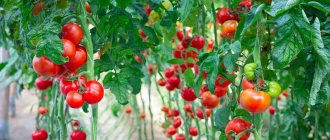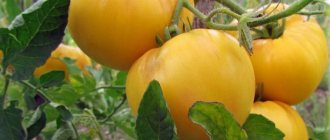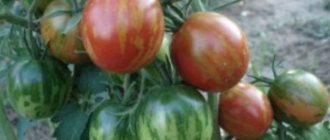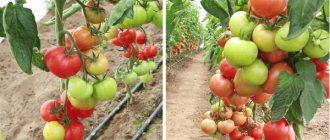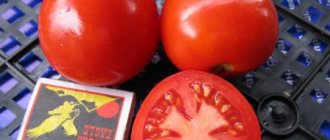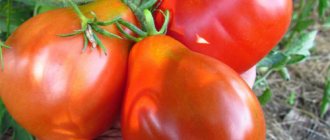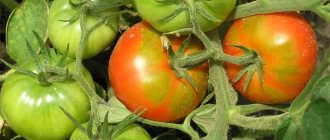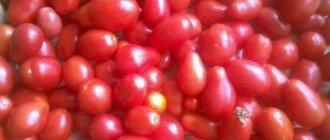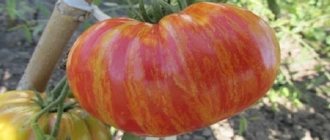Recently, balcony tomato seeds began to appear on sale. This is the name of varieties intended for growing on open loggias and balconies. Pygmy is one of these cultivars. It appeared thanks to the efforts of domestic specialists.
| Height | Landing location | Ripening time | Fruit color | Fruit size | Origin | Fruit shape |
| short | Open ground | Ultra early | Reds | Small | Variety | Round |
Characteristics of the Pygmy tomato variety
Characteristics of the Pygmy variety:
- Tomatoes got their name because of their short growth. The bushes reach a height of 30 cm.
- They are miniature, compact, of limited growth, the main stem ends in a flower raceme.
- In addition to all this, they are decorative.
- Seedlings are grown in any containers or containers.
- The seeds of this tomato variety are produced by the agricultural industry.
Continuing the description of the variety, let’s pay attention to the shoots. The stems of the plant are low and even, with a moderate amount of leaves. The bush is usually not formed. The initial ovaries appear at the level of 6-7 leaves, and subsequent ones appear through the leaf. They form brushes on which 5-7 ovaries appear.
It is also necessary to mention the early ripening of this tomato variety. The harvest ripens 3 months after planting the seedlings. A lot of tomatoes grow on 1 bush. They are all small in size, smooth and with a fairly dense skin that never cracks. The weight of each tomato is 24-26 g. From 1 m² you can harvest up to 5 kg of tomatoes.
These tomatoes are successfully used both fresh and for canning. The taste of tomatoes depends on weather conditions. The more heat and sun the plant receives, the sweeter the fruits become. Growing in damp and cold conditions imparts sourness to the fruit.
Planting black currants
Black currants like to receive a lot of sun, that is, light and warmth, so set aside a corner for it in the southern or southwestern part of the garden. Make sure that the soil acidity is low, as this crop does not like to grow in other conditions. Do liming to be on the safe side, just in case. About 200–250 g of lime powder are scattered per square meter for digging. On highly acidified soils, the application rate can reach 600–700 g.
Time and landing pattern
There are two periods in the season for planting Pygmy currants: the first is in April-May, the second in September-October. It is preferable to plant the plant in the fall, and so that it has time to take root before the onset of cold weather. In the spring, melt water will significantly compact the soil around the roots, and they will begin to grow even more actively.
Plant black currants in a place open to the sun, but so that the tree trunk is protected from direct sunlight
Pygmy bushes are quite compact, so when planting, you can leave 1.5–2 meters between them so that they receive sufficient light and ventilation. Try to arrange the plants in such a way that the tree trunks under them are protected from direct sunlight.
Selection of planting material
Actually, a seedling in a container is an excellent purchase that can save you a lot of trouble. However, such a purchase will cost more than a seedling with an open root system. It is much easier to purchase the latter, because in spring and autumn it is sold everywhere: at bazaars, in shops and ordinary private shops. The most reliable way to buy a plant is not from hand, but from trusted nurseries or stores. The closer such a place is to your site, the better.
Buy seedlings from trusted nurseries that value their reputation and sell only quality products
Choosing a healthy seedling is not difficult. Its roots should be elastic and moist (if they are exposed), and light green or white fibers should be visible under the bark when lightly cut. Try not to purchase plants with obvious damage, signs of disease or dry roots.
Gardeners often take one bush of one variety or another for testing, but in reality it is better to purchase two or three specimens to get a larger harvest from each of them.
Carefully inspect the blackcurrant seedling before purchasing: its roots should be elastic and moisturized, and the presence of leaves will only confirm the good condition of the plant
Landing
Planting black currants is not as difficult as it might seem, but it still requires compliance with certain conditions.
- At the selected location, carefully dig up the soil, remove all weeds and plant debris.
- Dig a hole for a seedling 50–60 cm in diameter and up to 40 cm in depth. The top fertile layer is removed and set aside.
- A nutrient mixture consisting of a bucket of compost, 200 g of superphosphate and 50–60 g of potassium sulfate is placed in the pit. All these ingredients are mixed with infertile soil.
- The roots of the seedling are dipped in clay mash, which is obtained by diluting the clay to a semi-liquid state in water.
- The seedling is placed vertically or at an angle so that in the future it can grow more branches.
- Currant roots are sprinkled with fertile soil, with the root collar being 5 cm below the zero level.
- After planting, all shoots are pruned so that no more than three healthy buds remain on each to stimulate active growth.
- A small depression is made around the seedling for watering. One bush requires about 7 liters of water.
- After watering, the tree trunk circle is mulched with peat, humus or sawdust to better retain moisture in the roots.
A seedling in a container will take root much faster in a new location and can be planted throughout the season.
Advantages and disadvantages of the Pygmy variety
Let's look at the disadvantages and advantages of Pygmy tomatoes. The disadvantages include the low yield of the crop and the small size of the bush and fruit. This variety has many more advantages.
Firstly, they can be grown at home: on a windowsill or open balcony.
Secondly, the fruits ripen very quickly, so very soon you will be able to enjoy the result of your labors. Well, an important point is that the variety is resistant to fungal diseases.
Rules of care
Caring for indoor tomatoes is quite simple, but it is recommended to adhere to the rules of agricultural technology, which are prescribed by the peculiarities of this type of vegetable cultivation.
Watering and fertilizing
Indoor tomatoes are very responsive to watering, which has a positive effect on the formation of ovaries, as well as the filling and ripening of fruits. The soil should be constantly moist, without deep drying, which often provokes dropping of fruits. However, excessive waterlogging can cause many tomato diseases.
To increase the immunity of a houseplant, as well as provide it with the amount of nutrients necessary for growth and development, fertilizers should be applied twice a month. Fertilizing indoor tomatoes is carried out using special fertilizers for vegetable crops. The use of nitroammophosphate and superphosphates or the use of complex fertilizer “Sudarushka-Tomato” also shows good results.
Additional lighting
Despite the fact that many new varieties intended for indoor growing have increased resistance to insufficient lighting and are capable of producing a crop even with a small amount of it, additional illumination with special lamps allows not only to increase the yield, but also to extend the fruiting period.
Tying and pinching
A limited number of varieties suitable for cultivation under indoor conditions require pinching, bush formation and tying. Most often, these shade-tolerant plants are low-growing, single-stemmed and grow well without staking or support. At the same time, low varieties of tomatoes are capable of producing about 1.5-2 kg of ripe fruits from each bush.
How to collect tomato seeds at home
Self-harvested tomato seeds have the advantage of good germination rates and allow you to obtain very strong seedlings that are resistant to various diseases. In addition, tomatoes grown from their own seeds have greater productivity and high yield.
The resulting seed material should be washed several times with clean warm water, and then dried on gauze or on fabrics that absorb water well. After complete drying, the seeds are packaged in envelopes, which should be signed and stored at room conditions, but not more than five years. It should be remembered that hybrid tomatoes are not suitable for harvesting seeds.
Disease Prevention
To protect indoor tomato bushes from damage by the most common diseases and pests, preventive spraying should be carried out with the following preparations:
- against late blight, spraying with “Quadris”, “Ridomil-gold” and the drug “Bravo” is used;
- to protect against anthracnose, use “Quadris” or “Tiovit-jet”;
- “Strobi” and “Fitolavin-300” show high effectiveness against spotting.
Growing tomatoes
Growing seedlings should begin in April. After the first leaves appear, you can start picking. After 35 days, the seedlings are planted in open ground. Although many managed to grow the plant by sowing the seeds directly into open ground.
Tomatoes of this variety have another unique feature: they can also be grown in winter. You just need to provide them with lighting. If you want to enjoy ripe tomatoes in winter, the seeds should be planted in October.
Cultivation is carried out according to the following scheme:
Seed preparation
Most gardeners purchase Japanese dwarf seeds from their fellow hobbyists. Such planting material must be checked for germination. To do this, soak it for half an hour in a glass of water with the addition of 1 teaspoon of salt. Floated specimens are collected and thrown away. The seeds that have sunk to the bottom are washed and used for planting.
Planting material must be disinfected. To do this, it is soaked for 20 minutes in hydrogen peroxide or a light pink solution of potassium permanganate.
Another option is soaking in a growth stimulant. Use “Sodium Humate”, “Epin” or “Zircon”. As folk remedies that accelerate the germination of planting material, use water with honey, soda solution or aloe juice.
Preparation of soil mixture and selection of containers
For tomato seedlings, choose light but nutritious soil. Suitable compositions are sold in specialized stores, but most gardeners prefer to prepare the soil themselves.
There are many ways to prepare soil for tomatoes. The list contains several good options:
- Equal parts of black soil and peat are mixed. Add 0.5 parts of humus and 1 part of river sand to the resulting composition. Take 10 g of ammonium nitrate and potassium chloride per bucket of the resulting mixture.
- For 3 kg of peat, take 1 kg of sawdust, 0.5 kg of mullein and 1.5 kg of river sand. For this amount of soil mixture, take 5 g of ammonium nitrate and potassium chloride, as well as 10 g of superphosphate.
- Peat, humus, garden soil and sawdust are mixed in equal proportions. For a bucket of mixture take 1.5 tbsp of ash, 1 tbsp. l potassium sulfate, 3 tbsp. l superphosphate and 1 tsp urea.
The soil for tomatoes needs to be disinfected. To do this, it is calcined in the oven or poured with a dark pink solution of potassium permanganate.
To sow seeds, take large shallow containers. They use both special trays, cassettes and boxes, as well as improvised means.
For picking plants, use any deep containers with a volume of at least 300 ml. Drainage holes are made at the bottom of homemade pots.
All dishes for sowing seeds are disinfected - soaked in a dark pink solution of potassium permanganate.
Sowing seeds
Japanese dwarf is an inexpensive and unpretentious variety. More often it is grown by sowing seeds in one large container and then planting them in individual pots.
Soil is poured into the seedling box. The soil is watered abundantly and leveled. Make grooves 1 cm deep at a distance of 2-3 cm from each other. Seeds are placed in them at intervals of 2 cm.
The seeds are covered with soil. The containers are covered with film and placed in a warm place with a temperature of 24-26 ºC.
Rules for caring for seedlings
Growing tomato seedlings is not difficult. You just need to follow the basic rules for caring for it:
- When the first shoots appear, the film is removed from the boxes. They are moved to a well-lit place. Experienced gardeners recommend that after seed germination, place the seedlings in a room with a temperature of 17 ºC for a week. The plants are then placed in a warm place. This will prevent the tomatoes from pulling out prematurely.
- Water the tomatoes with warm water. Water should not fall on the above-ground part of the plant. The frequency of watering depends on the rate of drying of the soil.
- When real (not cotyledon) leaves appear, the tomatoes are dived into separate pots. A layer of drainage is placed at the bottom of the containers. There is no need to pinch the roots of the plants.
- It is fed 3 times during the period of growing seedlings. The first time 2 weeks after picking into individual containers, the second time 14 days after the previous feeding, the last time 5 days before planting tomatoes in open ground. Use complex fertilizers or vermicompost.
- Hardening off tomatoes will allow them to quickly adapt to open ground conditions. To do this, the seedlings are taken outside every day for several hours. The procedure begins 2 weeks before planting the tomatoes in a permanent place.
Description and main characteristics of the variety
Pygmy fully lives up to its name - the bushes of these tomatoes are miniature, compact, standard, determinate, and can reach only 0.3 m in height, really small compared to ordinary tomatoes grown in beds or in greenhouse conditions.
In addition to good yields for miniature varieties of vegetables, the Pygmy variety has excellent decorative properties. Growing seedlings of this tomato can be done in pots, patios, on balconies - in containers and other containers. This miniature tomato can be an excellent compactor among tall varieties of tomatoes in greenhouses and under film coverings.
Features of care
Usually the Pygmy variety is grown using seedlings. Movra is sown in April and plucked when two full green leaves are formed. The reduction is carried out to a depth of 1.5 cm. You can also use a growing method such as planting seeds directly in open ground. When planting seedlings for a permanent place of growth, water immediately
It should be moderate and preferably water at room temperature. It is necessary to loosen the soil for some time after watering, since under the weight of water the plant compacts, becomes dense and the access of oxygen to the root system is limited. It is important to carry out weeding, removing weeds in a timely manner. Excess grass takes away the nutrients the plant needs, resulting in what's the matter? its growth may slow down. It is enough to apply fertilizer 2 - 3 times per season.
Fertilizers can be either mineral or organic. Bushes love spraying, so periodically you can give them a “shower” with a spray bottle. This will remove settled husks from plants (those growing indoors), and will also serve as a preventive measure against the occurrence of pests.
The Pygmy tomato variety is simply a godsend for all those who dream of growing vegetables and do not have a summer cottage. Their compact size allows you to grow and obtain delicious fruits at home, in an apartment. Wazhnecki also grow in open areas. The variety is unpretentious in care and responsive to feeding. Decorative bushes will perfectly decorate any place where they are planted. The taste of the fruit can be sour or sweet, depending on climatic conditions. Despite this, they will suit any table. They can be consumed fresh, without cutting, as well as canned as a whole.
Advantages and disadvantages of the variety
The advantages of the Pygmy variety include:
- possible cultivation of tomato on a balcony, window sill, as a sealant in border flower beds and in greenhouses;
- early ripening of fruits;
- fruits not prone to cracking;
- compactness of bushes;
- The variety is resistant to major fungal diseases, in particular late blight.
Disadvantages include below average yields, as well as the bushes being too small.
